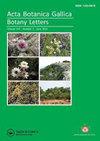A test of four candidate barcoding markers for the identification of geographically widespread Chimaphila species (Pyroleae, Ericaceae)
引用次数: 2
Abstract
Abstract DNA barcoding has been widely used as a tool for species discrimination in closely related plants and at more coarse taxonomic levels, but there have been few reports of such a tool being applied to taxa in “morphological stasis”. In this study, we test the performance of core barcodes (rbcL and matK) and two additional candidate barcodes [psbA-trnH and nuclear ribosomal internal transcribed spacer (ITS)] for the widely distributed, northern temperate monophyletic genus Chimaphila, which exhibits morphological conservatism. In addition to ITS, slowly evolving rbcL and matK independently demonstrate a high resolving ability among Chimaphila species, indicative of the old age of disjunction. We tentatively attribute morphological stasis in Chimaphila to convergence under similar habitat conditions and complex, stable relationships with surrounding autotrophic trees via common mycorrhizal symbioses.四种候选条形码标记在地理上广泛分布的chimaphia (Pyroleae, Ericaceae)种鉴定中的应用
DNA条形码作为一种近缘植物和较粗的分类水平上的物种识别工具已被广泛使用,但将其应用于“形态停滞”分类群的报道很少。在这项研究中,我们测试了核心条形码(rbcL和matK)和两个额外的候选条形码[psbA-trnH和核糖体内部转录间隔(ITS)]对广泛分布的北温带单系Chimaphila属的性能,该属具有形态保守性。除了ITS外,缓慢进化的rbcL和matK在chimapphila物种中独立表现出很高的分辨能力,表明分离的年龄较长。我们初步将Chimaphila的形态停滞归因于在相似的生境条件下的趋同,以及通过共同的菌根共生与周围自养树木建立复杂、稳定的关系。
本文章由计算机程序翻译,如有差异,请以英文原文为准。
求助全文
约1分钟内获得全文
求助全文

 求助内容:
求助内容: 应助结果提醒方式:
应助结果提醒方式:


